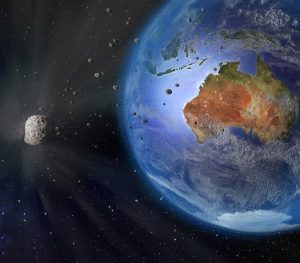Spotting and tracking asteroids is especially difficult given the objects’ dark characteristics. Because the asteroids only reflect 10 to 15 percent of sunlight, ground-based telescopes, and other types of advanced imaging technology, are tasked with finding dim bodies in a wide field of view. Being able to predict the path of an asteroid is similar to determining the trajectory of a hurricane. Their position, speed and direction can be measured, but there are always uncertainties in each of these measurements.
Just as changing conditions in the atmosphere and ocean can alter the path of a hurricane, gravitational tugs from the planets can modify the orbit of an asteroid. Continued tracking of potential threats is highly recommended.
Approximately 1,500 near-earth objects (NEOs), such as asteroids and comets, are detected each year, and more than 13,500 NEOs have been discovered since NASA-led surveys began in 1998.
On Wednesday, April 19, 2017, “JO25” missed Earth by 1.1 million miles – a distance closer than you might think. The “JO25” asteroid stood out because of its size: ju st under 1 kilometer in its long axis and 650 meters in its short axis, roughly 2,000 feet. The asteroid’s peanut-like shape is considered “bifurcated,” appearing almost like two asteroids stuck together.
st under 1 kilometer in its long axis and 650 meters in its short axis, roughly 2,000 feet. The asteroid’s peanut-like shape is considered “bifurcated,” appearing almost like two asteroids stuck together.
The sighting of asteroid “2014 JO25” demonstrated the importance of collaborative observations and advanced imaging technology to follow and characterize potentially hazardous comets and asteroids in the sky.
Astronomers discovered 2014 J025 in … you guessed it … 2014. This was the closest encounter with Earth in the last 400 years. NASA said telescopes around the world were trained on this asteroid during the flyby to try to learn more about it. It was also the largest asteroid to approach Earth since September of 2004.
NASA’s Planetary Defense Officer, Lindley Johnson leads the global effort to detect and follow near-earth objects like JO25 – ones capable of speeds as high as 12 miles per second.
“An object of that size, if it were to impact on land somewhere, it could pretty much wipe out a region of a large state,” said Johnson. “The effects could well affect the climate globally for a period of several months.”
NASA’s Planetary Defense Coordination Office (PDCO), managed at NASA Headquarters in Washington, D.C, is responsible for early detection of potentially hazardous objects, like asteroids and comets, and issues warnings about their potential impacts.
To characterize and track an asteroid like JO25 requires teamwork from observatories around the world, with ground-based telescopes provide observations of moving objects in the sky.
The images and orbital data are then sent them to a database at the International Astronomical Union Minor Planet Center. The NASA-supported and internationally sanctioned facility, based in Cambridge, MA, analyzes the data related to small bodies in the solar system.
At UKA, our team of designers and developers work with you and your specific needs to manufacture your lens with precision and accuracy. Our entire process is done in-house giving you the assurance we have your project being monitored at all stages.
“Although [the telescopes are] rather sophisticated technology, relatively speaking, they still lack what we need to be able to cover as much of the sky, as deep as we need to, to detect these objects,” said Johnson.
A possible way to upgrade asteroid-discovery capabilities is the use of space-based infrared (IR) telescopes. Instead of looking for the reflection of light against dark objects, IR technology detects an object’s re-emitted heat, offering a full surface area of an asteroid and better signature against the cold background of the sky. According to Johnson, an infrared telescope in space would be more effective for detecting and tracking objects.
“With the NEOWISE lessons learned, we could now build a robust space-based telescope that will find tens of thousands of asteroids each year for the cost of a Discovery-class mission.”
Having the ability to detect such asteroids and possibly deflect them, has the potential to keep incidents like the one in February of 2013 that exploded over the skies of Chelyabinsk, Russia from occurring.
Universe Kogaku designs and manufactures optical lenses for advanced imaging technology, security, high tech and electronic applications. We stock 1000’s of standard lens assemblies and can custom design a solution for scanners, CCTV, CCD/CMOS, medical imaging, surveillance systems, machine vision and night vision systems.